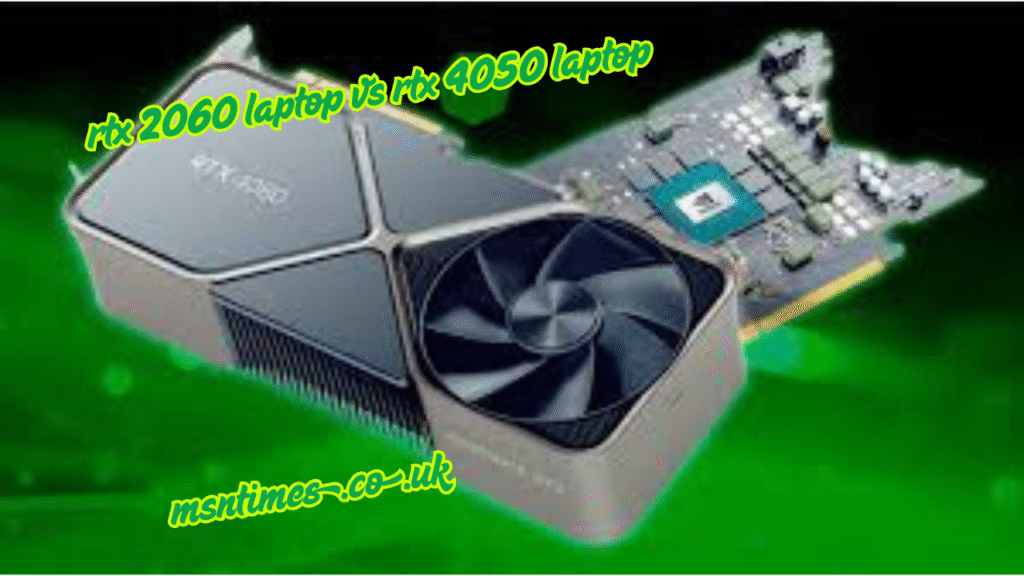The laptop GPU market has seen a significant evolution over the years. With NVIDIA’s RTX 20-series making a splash back in 2019, and the newer 40-series arriving with Ada Lovelace architecture, gamers and content creators are now weighing their options between the RTX 2060 laptop vs RTX 4050 laptop. But which one is the better buy in 2025?? Let’s break it down across performance, architecture, efficiency, pricing, and real-world usage.
GPU Architecture and Technology Leap

The RTX 2060 laptop is based on NVIDIA’s Turing architecture, which introduced real-time ray tracing and DLSS for the first time. At its debut, it was a revolutionary piece of tech for laptops, offering solid 1080p gaming performance and new visual fidelity enhancements.
In contrast, the RTX 4050 laptop uses the Ada Lovelace architecture, a much more refined and efficient design. Ada brings 3rd-generation ray tracing cores, 4th-generation Tensor cores, and support for DLSS 3.0, including Frame Generation. This means smoother gameplay, better frame rates, and improved power efficiency, all in a more compact thermal footprint.
Performance: RTX 2060 Laptop vs RTX 4050 Laptop

In raw performance terms, the RTX 4050 laptop comfortably outpaces the RTX 2060 laptop. Benchmarks show that the 4050 can outperform the 2060 by up to 30-40% in many AAA titles and productivity tasks.
For example:
- In games like Cyberpunk 2077, the RTX 4050 can handle 1080p ultra settings with DLSS 3 and achieve over 60 FPS, while the RTX 2060 may struggle even with DLSS 2 enabled.
- In creative software such as Adobe Premiere Pro or Blender, the 4050 leverages newer Tensor cores and higher CUDA core counts to speed up rendering and encoding.
Overall, if performance is your priority, especially for future-proofing, the RTX 4050 laptop holds a notable advantage.
Power Efficiency and Thermals

Another key difference in the RTX 2060 laptop vs RTX 4050 laptop debate is power consumption. The 2060, being older and built on a less efficient node, tends to run hotter and draw more power. This can result in louder fans and shorter battery life.
On the flip side, the RTX 4050 benefits from Ada Lovelace’s 5nm manufacturing process, resulting in better power efficiency. This means quieter operation, less thermal throttling, and improved battery longevity in real-world usage scenarios.
For users who prefer thin-and-light laptops or need quiet machines for office environments, the RTX 4050 laptop clearly wins.
DLSS and Ray Tracing Capabilities
DLSS (Deep Learning Super Sampling) is a game-changer for NVIDIA GPUs. The RTX 2060 laptop supports DLSS 2.0, which already boosts performance by rendering at lower resolutions and using AI to upscale the image. However, it doesn’t support Frame Generation, a major DLSS 3 feature.
The RTX 4050 laptop, with DLSS 3 support, offers Frame Generation and better upscaling quality. This translates into smoother gameplay even when the GPU is under heavy load. For ray tracing, the 4050 also features more advanced cores that handle reflections, shadows, and global illumination with higher accuracy and speed.
If you play ray-traced games or want to leverage DLSS to its fullest, the RTX 4050 laptop is significantly more capable.
Price and Value in 2025??
One of the most critical considerations in choosing between an RTX 2060 laptop vs RTX 4050 laptop is price. Because the 2060 is now an older model, laptops with it may come cheaper in the refurbished or clearance market. This could be a budget-friendly entry point for casual gamers or students who don’t need cutting-edge performance.
However, for new purchases, the RTX 4050 is the go-to choice. While it may cost slightly more, it delivers far better performance per dollar, lower power draw, and longer software support. Given the age of the 2060, future driver updates and compatibility might also become limited.
Thus, if you’re buying new in 2025??, the RTX 4050 laptop offers more long-term value despite a potentially higher upfront cost.
Real-World Gaming and Productivity Usage
In everyday use, whether you’re gaming, streaming, or working with demanding creative software, the RTX 4050 laptop feels more modern and responsive. Games load faster, frame rates are smoother, and multitasking is more seamless thanks to better GPU memory management and newer driver support.
Meanwhile, the RTX 2060 laptop still holds its own in older or less demanding games like Valorant, CS:GO, or GTA V, but starts to show its age with newer titles or software that require more GPU bandwidth.
If your workload includes ray tracing, 4K video editing, or you want to keep your laptop for several years, the newer architecture of the RTX 4050 laptop will offer more headroom.
Portability, Form Factors, and Thermals
The RTX 4050 laptop is usually found in sleeker, thinner designs due to its lower TGP (Total Graphics Power). These laptops often weigh less and have better battery life compared to older, bulkier RTX 2060 models that needed more robust cooling systems.
This makes the RTX 4050 laptops more travel-friendly and versatile for students, digital nomads, and professionals on the go.
Final Verdict: RTX 2060 Laptop vs RTX 4050 Laptop??
Summing it all up:
- RTX 4050 laptop is clearly superior in performance, efficiency, ray tracing, DLSS, and long-term viability.
- RTX 2060 laptop might still serve well for budget-conscious users or legacy workloads but lacks the modern features and speed of newer GPUs.
In 2025??, unless you have a very tight budget or are picking up a used model at a great discount, the RTX 4050 laptop is the smarter and more future-ready choice. It not only gives you better frame rates but also ensures you’re ready for the next generation of games and software.
So, in the contest of RTX 2060 laptop vs RTX 4050 laptop, the RTX 4050 takes the crown in nearly every category.
Also Read : Long Established Lifestyle Magazine Crossword Clue: Unraveling the Answer
